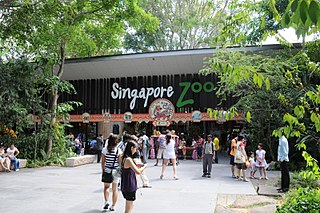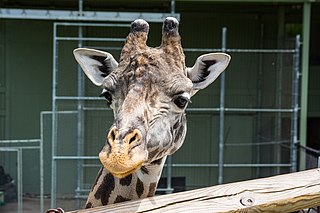Related Research Articles

Bristol Zoo was a zoo in the city of Bristol in South West England. The zoo's stated mission was to "maintain and defend” biodiversity through breeding endangered species, conserving threatened species and habitats and promoting a wider understanding of the natural world".

Jersey Zoo is a zoological park established in 1959 on the island of Jersey in the English Channel by naturalist and writer Gerald Durrell (1925–1995). It is operated by the Durrell Wildlife Conservation Trust. It has approximately 169,000 visitors per year; visitor numbers tend to vary with the tourist trade to Jersey.

The Singapore Zoo, formerly known as the Singapore Zoological Gardens or Mandai Zoo, is a 28 hectares zoo located on the margins of Upper Seletar Reservoir within Singapore's heavily forested central catchment area. Opened in 1973, the zoo was built at a cost of $9 million that was granted by the government of Singapore.

The Oakland Zoo is a zoo located in the Grass Valley neighborhood of Oakland, California, United States. Established on June 6, 1922, it is managed by the Conservation Society of California, a 501(c)(3) non-profit organization dedicated to the conservation of wildlife both locally and globally. The zoo is home to more than 850 native and exotic animals. It is recognized for its outstanding leadership in animal welfare, animal care, particularly its elephant care program, its rescue, rehabilitation and conservation programs and for its Leed-certified, 17,000-square-foot, state-of-the-art veterinary hospital—the largest wild animal veterinary facility in Northern California. Oakland Zoo is the recipient of numerous "Best of" awards, including 30 Best U.S. Zoos by U.S. News & World Report and "10 Best" by USA Today Reader’s Choice Awards.

Zoo Atlanta is an Association of Zoos and Aquariums (AZA) accredited zoological park in Atlanta, Georgia. The current president and CEO of Zoo Atlanta is Raymond B. King.

Melbourne Zoo is a zoo in Melbourne, Australia. It is located within Royal Park in Parkville, approximately 4 kilometres (2.5 mi) north of the centre of Melbourne. It is the primary zoo serving Melbourne. As of 2021 the zoo contains 3742 animals comprising 243 species, from Australia and around the world. The zoo is accessible via Royal Park station on the Upfield railway line, and is also accessible via tram routes 58 and 19, as well as by bicycle on the Capital City Trail. Bicycles are not allowed inside the zoo itself.

Chester Zoo is a zoo at Upton-by-Chester, Cheshire, England. Chester Zoo was opened in 1931 by George Mottershead and his family. It is one of the UK's largest zoos at 51 hectares. The zoo has a total land holding of approximately 160 hectares.

The Los Angeles Zoo and Botanical Gardens is a 133-acre (54 ha) zoo founded in 1966 and located in Los Angeles, California. The city of Los Angeles owns the zoo, its land and facilities, and the animals. Animal care, grounds maintenance, construction, education, public information, and administrative staff are city employees. As of June 2019, Denise M. Verret serves as the zoo's director, the first female African American director of an Association of Zoos and Aquariums-accredited institution.

Brookfield Zoo, also known as the Chicago Zoological Park, is a zoo located in the Chicago suburb of Brookfield, Illinois. It houses around 450 species of animals in an area of 216 acres (87 ha). It opened on July 1, 1934, and quickly gained international recognition for using moats and ditches instead of cages to separate animals from visitors and from other animals. The zoo was also the first in America to exhibit giant pandas, one of which has been taxidermied and put on display in Chicago's Field Museum of Natural History. In 1960, Brookfield Zoo built the nation's first fully indoor dolphin exhibit, and in the 1980s, the zoo introduced Tropic World, the first fully indoor rainforest simulation and the then-largest indoor zoo exhibit in the world.

The Oklahoma City Zoo and Botanical Garden is a zoo and botanical garden located in Oklahoma City's Adventure District in northeast Oklahoma City, Oklahoma.

Happy Hollow Park & Zoo is a small 16-acre (6.5 ha) zoo and amusement park in San Jose, California, which originally opened in 1961. It was closed in 2008 for major renovations, and opened its gates again on March 20, 2010.

Gladys Porter Zoo is a zoological and botanical park located in Brownsville, Texas, United States. The zoo officially opened on September 3, 1971, and currently averages over 424,000 visitors annually. Situated on 31 acres (13 ha), the zoo houses about 400 animal species and over 250 tropical and neo-tropical species and subspecies. It is the first zoo to have successfully bred the endangered Jentink's duiker. It is also the birthplace of Harambe, the gorilla.

Bioparco di Roma is a 17-hectare (42-acre) zoological garden located on part of the original Villa Borghese estate in Rome, Italy. There are 1,114 animals of 222 species maintained.

The American Species Survival Plan or SSP program was developed in 1981 by the (American) Association of Zoos and Aquariums to help ensure the survival of selected species in zoos and aquariums, most of which are threatened or endangered in the wild.

The San Antonio Zoo is an Association of Zoos and Aquariums-accredited zoo in Midtown San Antonio, Texas, United States. It is located in the city's Brackenridge Park. San Antonio Zoo is a 50+ acre zoo home to over 750 species, some of which are endangered or extinct in the wild, and an annual attendance of more than 1 million. It also runs non-animal attractions, such as the 2 ft narrow gauge San Antonio Zoo Eagle train ride, which first opened in 1956.

Barcelona Zoo is a zoo in the Parc de la Ciutadella in Barcelona, Catalonia, Spain. The zoo used to be internationally known as the home of Snowflake, the only known albino gorilla, who died in 2003.

Taman Safari Indonesia or simply Taman Safari are animal theme parks in Cisarua, Prigen, and Bali. Being part of the same organization, they are known as Taman Safari I, II and III. The most popular is Taman Safari I.
References
- ↑ KidStuff Public Relations (July 19, 2006). "Creative New Trading Card Game Xeko Wins Creative Child Magazine 2006 Toy of the Year Award" (PDF) (Press release). Archived from the original (PDF) on November 15, 2006. Retrieved December 22, 2006.
- ↑ "Search Results tnpcarticle2.asp : The National Parenting Center".
- ↑ "Xeko Debuts Its Fourth Earth-Saving Collectible Card Set, "Mission: China"". Archived from the original on August 1, 2008. Retrieved July 27, 2008.
- ↑ "Greenworks". Archived from the original on February 7, 2008. Retrieved December 28, 2007.
- ↑ "Artists : Xeko Shop - Xeko Cards, Starter Sets, Booster Packs, and Single Cards". Archived from the original on January 21, 2008. Retrieved December 28, 2007.
- ↑ "Ploughshare Tortoise : Xeko Shop - Xeko Cards, Starter Sets, Booster Packs, and Single Cards". Archived from the original on May 18, 2012. Retrieved October 29, 2011.